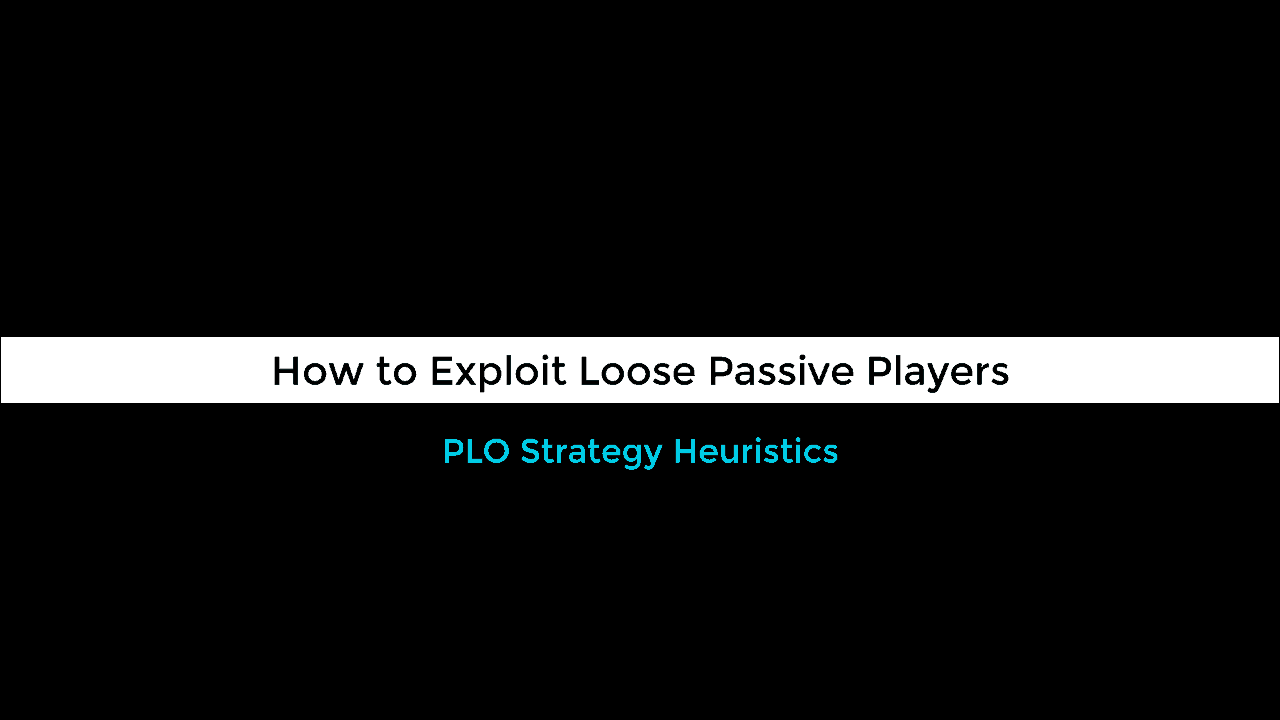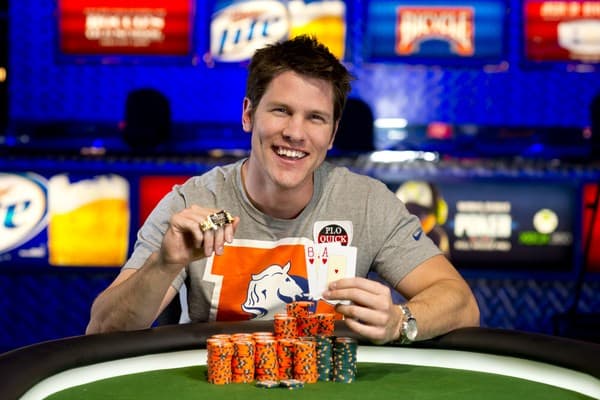Alfred North Whitehead
The best thing about doing research in an area with a huge game space that is largely unexplored is that one’s initial ‘best guesses’ at a strategy often turn out to be definitively bad. Online poker research provides very fast access to large samples of empirical data with which to test a theory before one gets too attached to it. When the evidence contradicts that theory we know we are about to learn something…
Most of you are comfortable with the idea of C-betting a lot on Ace-high boards as the 3-bettor and not C-betting so much on 876 duochrome. On boards like Q75r and 983d your decision metric likely consists of checking your opponent’s fold/raise/call versus a flop C-bet and little else. Construction of your checking range is usually an artefact of your C-bet construction rather than a conscious choice.
In this article I’m going to prove that, in principle, we need to protect our checking range in 3-bet pots when out of position. I’m going to explore the circumstances under which protection is especially important and when we can profitably deviate from ‘correct’ strategy.
If our opponent raises to 2.5x and we 3bet to 8x from the BB then the profitability of his pre-flop call is going to be affected by our flop C-bet strategy.
If our checks are 100% ‘honest’ (i.e. when we check it is always to check-fold
Under these assumptions we estimate his pre-flop call EV as:
EVCall= -5.5*C + 11*(1-C)
We set the EV = 0 to find the break-even point and we arrive at a value for C = 0.67
So if our checks are honest and our CB frequency is <=67% our opponent should call any hand he opens with.
Fit-or-fold
Whilst it’s hard to estimate exactly what his EV is for flopping trips-or-better, we can set a lower bound at picking up 50% of the post-flop pot once we C-bet. This is a very conservative estimate. We will assume we choose a pot-size C-bet since this range is ‘strong’ when we makes no attempt to protect our checking range. Thus when he hits and we C-bet he picks up half of a 24BB pot. Again we calculate the EV at the break-even point…
EVCall = -5.5*C*(BT miss) + 16.5*C*(BT hit) + 11*(1-C)
BT hit = 0.15, BT miss = 0.85 and thus, if we solve for C at EV = 0 we find
C = 83%
So even against a ‘Call anything, play fit-or-fold on the flop’ strategy the 3-bettor is going to have to C-bet 83% of the time on average to make the button ever consider folding pre-flop.
Notice that we haven’t yet made the 3-bettors strategy a losing proposition for him; the button is still losing 2.5BB per hand at the break-even point, and we are picking up 4BB/hand compared to folding. This is why one of the best strategies the button has to defend against aggressive 3-bettors is to not raise terrible hands in the first place.
Funnily enough, fit-or-fold is an underrated strategy by loose players. The reason it’s so effective to 3-bet a guy who calls A972 to a 3-bet is that he will continue inappropriately when he hits the board weakly. This leads to our expectation from 3-betting increasing since we make additional money when he calls the flop and folds on a later street or when he stacks off too light on boards that are awesome for our range. If he were just waiting for trips-or-better rather than continuing on AK6 textures he would make more money. The 3-bettor doesn’t need to worry about protecting his checking range when his opponent is playing poorly against his C-bet range.
It’s not a zero-sum sub-game
(3-bettor EV )= 4 – (Button EV) since there are 4BB of ‘dead money’ in the pot at the time the 3-bettor makes his 3bet-or-fold decision.
Now the fit-or-fold strategy forces us to C-bet a much more modest 54% of the time, even with a face up checking range. This is not as good news as it first appears because, in practice, our opponent’s range will be able to continue a lot more than 15% of the time. The better his hand selection pre-flop and the better he plays post-flop, the more this factor eats into the profitability of our ‘Checks are honest in 3-bet pots’ strategy.
Examination of the ‘Call 100% of 3-bets pre-flop, play fit-or-fold post-flop strategy’ has led us to an important insight. Flop texture is less of a factor in your C-bet decision when your opponent’s range contains a lot of poor hands. A high flop C-bet percentage is a strong strategy on most textures versus such players. We only need to even have a checking range to protect when our opponent stops filling up his pre-flop calling range with trash3.
The importance of check-call
However checking only to check-raise sometimes isn’t enough to protect our range. When we start checking some continuing hands, the button must risk 5.5 + (Check-raise frequency)*(Button Flop Bet Size) to take down the pot if we are constrained to check-raising or check-folding. This price is minimized trivially by minimizing his flop bet size.
Thus a strategy that includes only {Bet, check-raise, check-fold} and excludes check-call has a severe downside. Our opponent can now min-bet in position every time we check to make this strategy little better than when we were constrained to {Bet, check-fold}.
We have demonstrated that our optimal checking strategy is informed by our opponent’s response to our checks. We might get away with never check-calling against a player who always bets large when checked to, but against a player who either:
a) Includes a check back range or…
b) Bets small when checked to
we have no choice but to include a range which is going to be playable on the turn which means we’ll need to include some check-calls.
How to construct this check-call range is a longer and more complex discussion which necessitates experimention at the tables. I’ve shown you here the first step to improving your play in 3-bet pots. You’ll need to take the next one for yourself…
Want to make sure you get this concept nailed down? Deliberate practice is the best way to learn! Have a quick look at your CB frequency OOP in 3-bet pots and your check-fold frequency when you check. Share the two numbers in the comments below and write what (if anything) you would now change about your strategy. Until next time,
Quad
If you enjoy my work here and would like to learn more about the Mathematics of PLO, please take the time to fill out this short survey. Thanks for your continued support!







Flop Cbet OOP%: 66.7, Check-raise Flop%:12.5, Check/Call Flop%: 37.4, Check Fold Flop%:52. It seems chk/fold flop% is a bit too high?
filtered against 1 caller – CB 72%, XF 38%, XR 15%, XC 47%.
I was quite surprised to see such numbers. Continuing with almost 90% seems way too loose, probably should giveup more
CB frequency OOP in 3-bet pots 61% and check-fold frequency when I check 47.2%. Maybe tune down the cbet fq a litte bit more so that have to fold only around 30-35% when I check?
Defending as often as 53% when you check is very good compared to the field, so you’re probably pretty well protected. You’re only XFing the bottom 20% of your range on average. Remember, this is a global measurement, whereas your actually frequency should be texture and player-dependent. I’d look to up that C-bet frequency if I were you, unless you happen to be regularly playing deep stacked against strong players.
Hi Phil,
thank you for another great artilce.
I have a one question. If BB 3bet to 8bb and get called by IP position player the pot shouldnt be 16,5bb instead 24bb?
Hi gk,
Thanks for picking this up. By the time the 3-bettor C-bets there will be 33bb in the pot. We have assumed that when the button hits he collects 50% of the ‘post-flop pot once we C-bet’. 50% of 33bb is 16.5bb. I have edited the calculations accordingly.